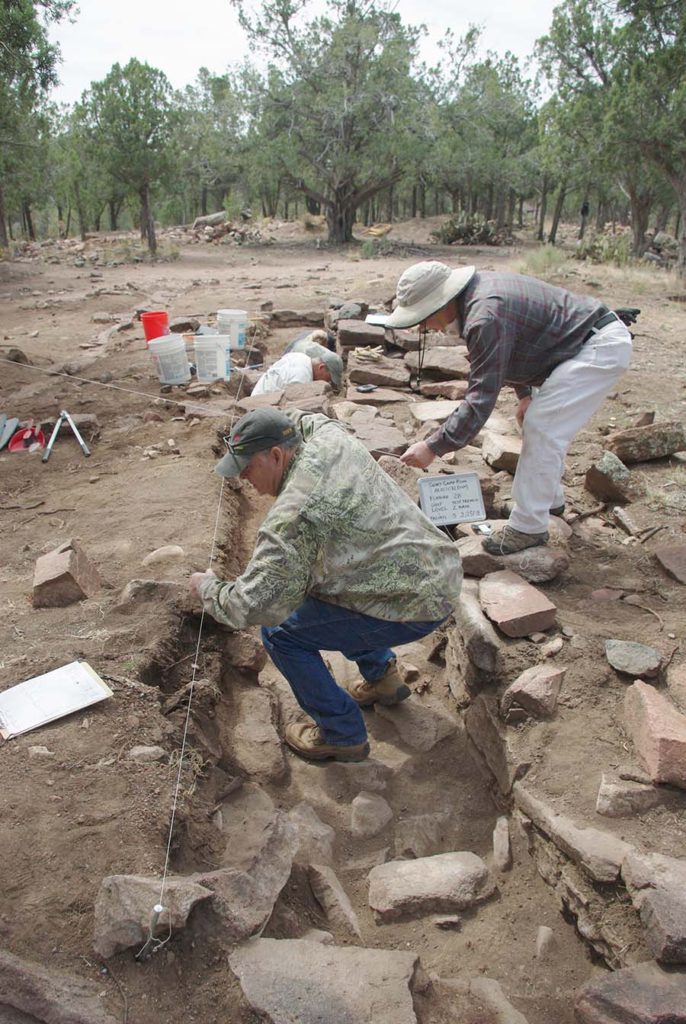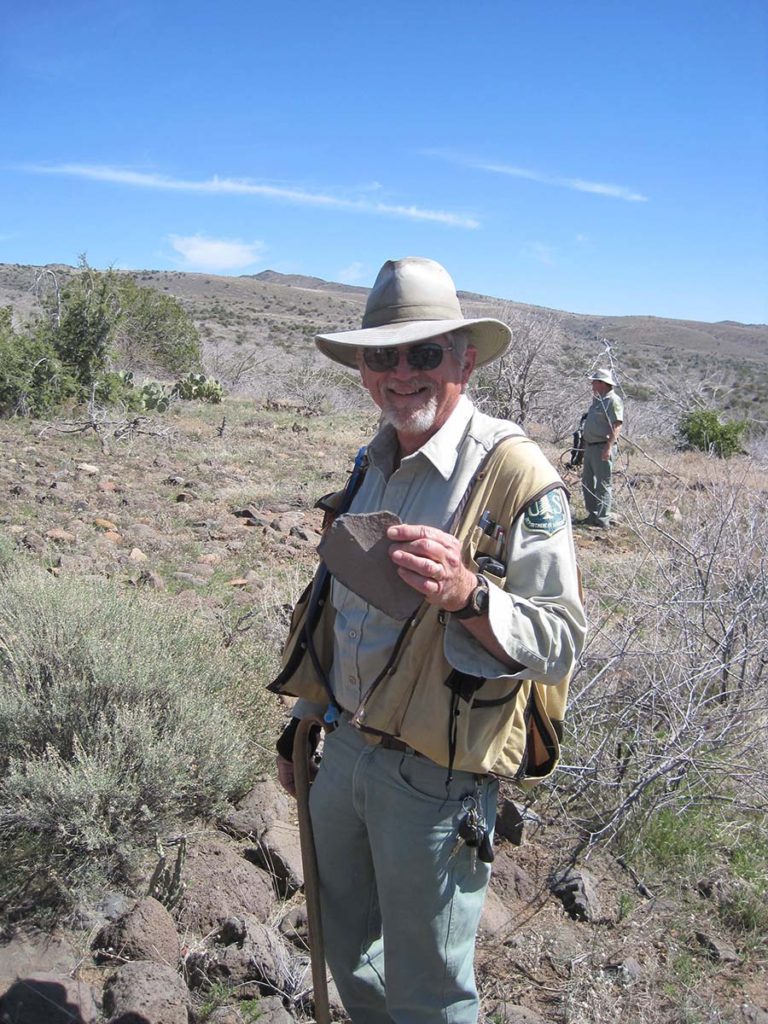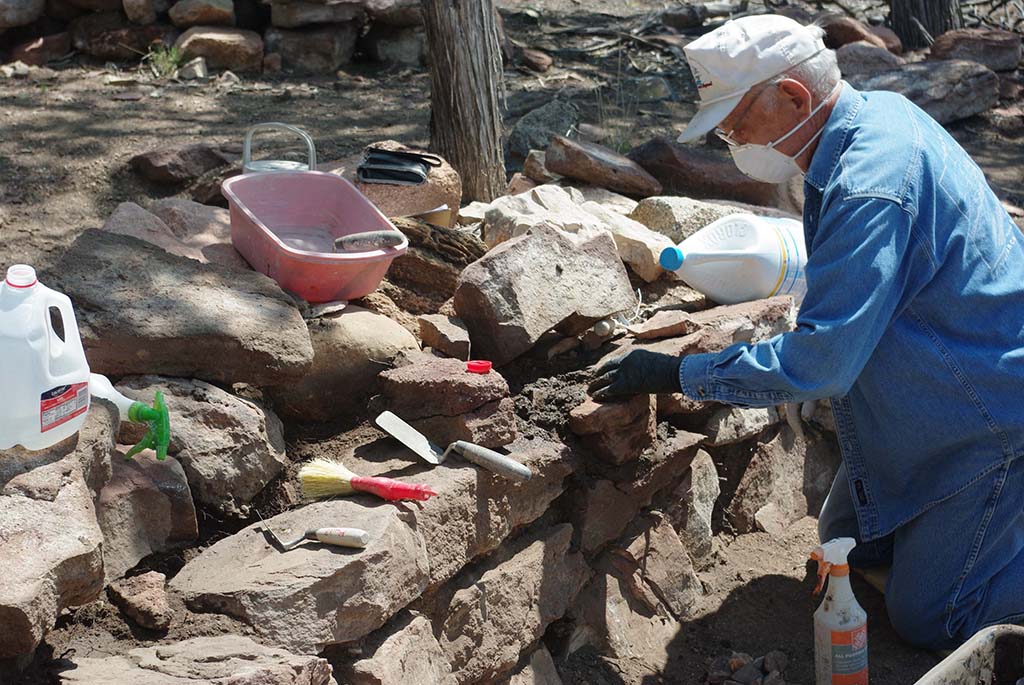Presents guest speaker Scott Wood Sept. 12
 Goat Camp Ruin is in the Payson area, much like Shoofly Ruin and Risser Ruin. It contains about 30 masonry rooms and other surface structures sitting on top of what was probably the largest pithouse village in the Payson area. The currently assumed occupation is approximately 750 to 1280 CE and the site appears to have been founded as a Hohokam colony which later became a significant part of local culture, though it was eventually surpassed in size and importance by both Shoofly and Risser ruins. The site was originally part of the Tonto National Forest but was transferred to the Town of Payson in a land exchange in 1994. With subsequent little activity for years, in 2008 the Rim Country Chapter of the Arizona Archaeology Society with Scott Wood’s assistance proposed to develop an archaeological interpretive site like Shoofly Ruin and a hiking trail for this 6-acre parcel of land. Scott has lead groups of volunteers each spring and fall the past 8 years mapping, surface collecting, and excavating and stabilizing several rooms within the overall complex with lab work taking place over the summers. The goal is not rebuilding or total excavation, but rather to further knowledge about the site and area that can be presented to the public through interpretive development. In his presentation, Scott provides a report on recent activities and findings at Goat Camp as well as plans for the future. He may even recruit you to join the crew…
Goat Camp Ruin is in the Payson area, much like Shoofly Ruin and Risser Ruin. It contains about 30 masonry rooms and other surface structures sitting on top of what was probably the largest pithouse village in the Payson area. The currently assumed occupation is approximately 750 to 1280 CE and the site appears to have been founded as a Hohokam colony which later became a significant part of local culture, though it was eventually surpassed in size and importance by both Shoofly and Risser ruins. The site was originally part of the Tonto National Forest but was transferred to the Town of Payson in a land exchange in 1994. With subsequent little activity for years, in 2008 the Rim Country Chapter of the Arizona Archaeology Society with Scott Wood’s assistance proposed to develop an archaeological interpretive site like Shoofly Ruin and a hiking trail for this 6-acre parcel of land. Scott has lead groups of volunteers each spring and fall the past 8 years mapping, surface collecting, and excavating and stabilizing several rooms within the overall complex with lab work taking place over the summers. The goal is not rebuilding or total excavation, but rather to further knowledge about the site and area that can be presented to the public through interpretive development. In his presentation, Scott provides a report on recent activities and findings at Goat Camp as well as plans for the future. He may even recruit you to join the crew…
 J. Scott Wood received his MA in Archaeology from Arizona State University and was an archaeologist for the Tonto National Forest for 40 years before retiring as Forest Archaeologist and Heritage Program Manager in 2015. During that time, he worked extensively with volunteers promoting public archaeology and the importance of incorporating citizen scientists in archaeological research. Before joining the Forest Service, he worked at the Museum of Northern Arizona, Pueblo Grande Museum, and at the ASU Office of Cultural Resource Management. In retirement, Scott continues as a professional advisor for two Arizona Archaeological Society Chapters (Desert Foothills and Rim Country). He helped found both the Arizona Archaeological Council and the Arizona Site Steward Program and now serves on the Board of Friends of the Tonto National Forest and as Vice Chair of the Arizona Site Stewards Program Foundation. Scott was named Arizona Archaeological Society Professional Archaeologist of the Year in 2011. His volunteer activities are extensive, developing public archaeological interpretive sites at Sears Kay and Goat Camp, assisting with training Arizona Site Stewards for the Arizona State Parks Department program, helping with AAS workshops/field schools/hike leader to specific areas of interest, and partnering with AAS and ASU Professor David Abbott in an attempt to identify the source population on Perry Mesa through survey and pottery temper studies. He is an author and coauthor of many publications and his Checklist of Pottery Types for the Tonto National Forest is a primary expert reference for prehistoric pottery in the Tonto National Forest, Central Arizona Tradition.
J. Scott Wood received his MA in Archaeology from Arizona State University and was an archaeologist for the Tonto National Forest for 40 years before retiring as Forest Archaeologist and Heritage Program Manager in 2015. During that time, he worked extensively with volunteers promoting public archaeology and the importance of incorporating citizen scientists in archaeological research. Before joining the Forest Service, he worked at the Museum of Northern Arizona, Pueblo Grande Museum, and at the ASU Office of Cultural Resource Management. In retirement, Scott continues as a professional advisor for two Arizona Archaeological Society Chapters (Desert Foothills and Rim Country). He helped found both the Arizona Archaeological Council and the Arizona Site Steward Program and now serves on the Board of Friends of the Tonto National Forest and as Vice Chair of the Arizona Site Stewards Program Foundation. Scott was named Arizona Archaeological Society Professional Archaeologist of the Year in 2011. His volunteer activities are extensive, developing public archaeological interpretive sites at Sears Kay and Goat Camp, assisting with training Arizona Site Stewards for the Arizona State Parks Department program, helping with AAS workshops/field schools/hike leader to specific areas of interest, and partnering with AAS and ASU Professor David Abbott in an attempt to identify the source population on Perry Mesa through survey and pottery temper studies. He is an author and coauthor of many publications and his Checklist of Pottery Types for the Tonto National Forest is a primary expert reference for prehistoric pottery in the Tonto National Forest, Central Arizona Tradition.
The public may attend an Arizona Archaeology Society – Desert Foothills Chapter meeting at no charge, except for the holiday party in December. The AAS-DFC meetings are held on the second Wednesday of each month, September through May. There are refreshments available at 7:00 PM and the meeting begins at 7:30 PM, usually ending prior to 9:00 PM. The meetings are held in the community room (Maitland Hall) at The Good Shepard of the Hills Episcopal Church, 6502 East Cave Creek Road, Cave Creek, AZ 85331 (near the Dairy Queen). www.azarchsoc.wildapricot.org/desertfoothills





